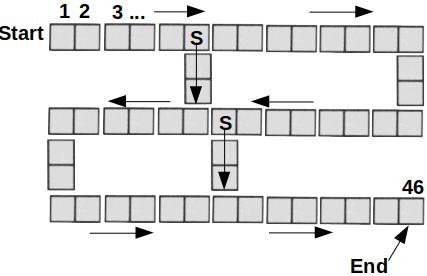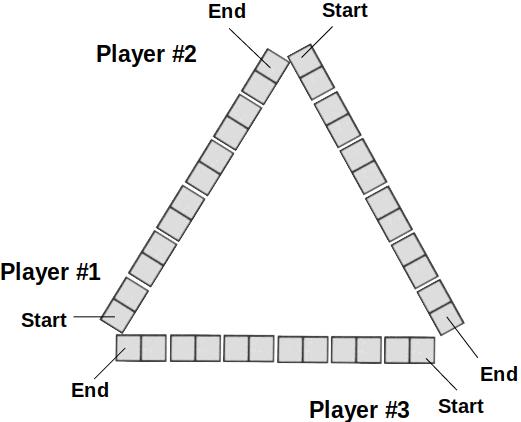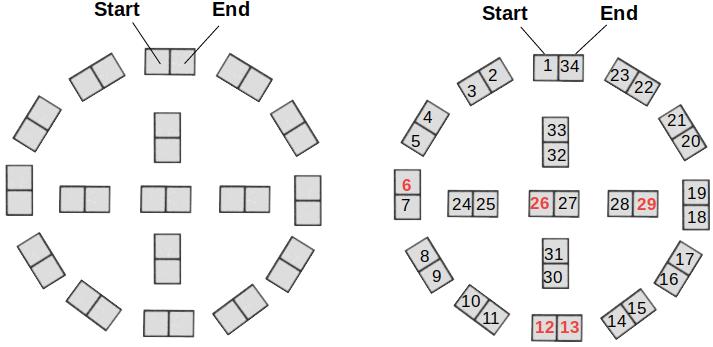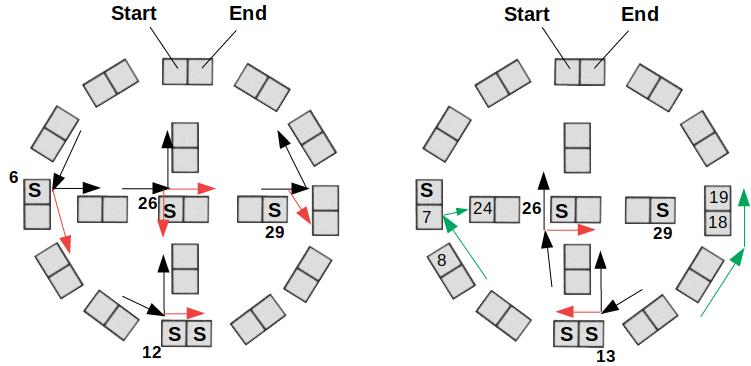Tabulus, Triangulus, and Druidica
Invented by Howard Fosdick © BestFreeNewGames.com
Here are three similar games: Tabulus, Triangulus, and Druidica. In them, you race your markers across a "board" composed of face-down dominoes. As the tiles turn up, you find your fate altered in unpredictable ways.
These three games share the same rules -- only the playing board differs:
Tabulus (aka Sisyphus or Domino Tabula) --
Overview: This simple but exciting game employs dominoes as the board across which players race markers. It differs from other racing games in that the board varies during play. Two variants of this game follow: one specifically for three players; the other, for more advanced play.
Players and Equipment: 2, 3, or 4 players. Each contestant uses four markers (pennies, nickels, dimes, and quarters work fine for the markers. Or use different-coloured poker chips). Four may play individually, or in two partnerships, with each player controlling three markers.
Use three sets of 6-6 dominoes. Large, heavy dominoes work best, since markers are placed upon them and they act as the game board.
Objective: To win the hand (or deal) by being first to move all four of one's markers across the raceway to the other end.
Start: Flip two 6-6 sets face down and shuffle. These become the drawing stock.
Take the third set of dominoes, shuffle them face down, then place 22 of them face down in this configuration:

This is the racing board. Each face down tile has two positions. Each position corresponds to one of the two numbers on the domino.
Players place their four markers off the board at the Start position. Players move their markers across the board in the pattern of a large "2". Markers may only move forward, towards End.
Two shortcuts are denoted by the "S" positions. Note that a marker taking the first shortcut then proceeds to the left, so it cannot subsequently take the second shortcut.
Markers can move through or past other markers on the board. Any number of markers may come to rest upon a single board position.
During play, events will cause some tiles on the board to be turned face up. Such tiles remain face up for the remainder of the hand.
Determine which player goes first by drawing tiles: the highest total pip count goes first. In subsequent hands, the loser of the previous hand goes first. If there are more than two players, turns proceed clockwise after the first player.
Play: In his turn, a player draws one tile from the drawing stock. The two numbers on that tile are considered two different movement factors. The player can elect to move one marker the total of the two numbers on the tile. Or, he can move two markers, each using one of the two numbers on that tile.
For example, draw a 6-2 tile, and you can move one marker 8 positions. Or move one marker 6 positions, and another marker 2 positions.
A player must always use both movement factors on the tile he draws if at all possible -- even if it forces him upon a route he'd prefer not to take. Or, if he physically can't use both movement factors, he must use the largest one possible.
If a player is not able to move a marker at all, he says "pass".
Entering a Marker onto the Board: To enter a marker onto the board from Start, a player must draw a tile that has a total pip count that is an even number (ie, 2, 4, 6, 8, 10, or 12). The player may then enter two markers onto the board, starting at position 1, using one movement factor for each. Or, he may enter a single marker and use both movement factors for it alone.
Bearing a Marker off the Board: To bear a marker off the board, the player must land the marker exactly on the End position, position 46. One cannot bear off a marker unless using a movement factor that lands the marker precisely on top of position 46.
The first player who lands on position 46, End, flips that tile face up. If it shows a blank (0) at position 46, that player must move his marker off the board back to Start. Otherwise the marker has successfully traversed the board and can be removed from play.
The blank test for End only applies to the first marker that lands on position 46. All subsequent markers do not face this challenge and are immediately borne off the board when they land on top of End.
Shortcuts: The two positions in the diagram above marked by "S" are shortcuts. The first player who decides to take one of the shortcuts announces the movement factor he is using to take the shortcut. Then he flips over the shortcut tile. If the movement factor he has declared he is greater than the number exposed at position "S", he moves his marker past the "S" tile in the shorter path.
If his declared movement factor is not greater than the "S" value, the player takes his marker off the board and back to Start. Note that only one movement factor can be used to challenge the shortcut (not the sum of the numbers on the tile).
For example, a player has a marker on board position 2. He draws a 6-4 tile. He says "I'm using my 6 to take the first shortcut". He flips over the shortcut tile. If the number beneath the "S" is less than 6, he takes the shortcut. If it is 6, he must remove his marker off the board back to Start.
The shortcut tile remains face up. So players know what this number is going forward. Thus, they can take the shortcut if they have an individual movement factor greater than the shortcut value. Otherwise they must take the longer path past the shortcut.
Note that if a shortcut displays a 6, no player can ever take the shortcut, and all markers must go past it the long way round.
Bumping: If a player lands his marker exactly on top of an opponent's, he can try to bump that marker off the board back to Start. The player announces "I'm bumping your marker", then he turns over the tile beneath. If the tile position shows any number other than blank (0), the opponent's marker is bumped and borne off the board back to Start. However, if that tile position shows a blank, then the player attempting the bump takes his marker off the board back to Start. The tile remains face up going forward.
Bumping is optional. Multiple markers from one or more players may reside on the same board position.
Any time a marker sits upon a face up tile position showing a blank, this is a safe spot from which no marker can ever be bumped.
Also, if one player has two or more markers on top of one another at the same tile position, none of his markers at that position can be bumped. Only when a player has a single marker at a position can it be bumped.
If markers from multiple players sit atop a position, the attacker must state in advance which one he intends to bump.
Doublets: Drawing any doublet always allows a player a second turn.
However, if a player draws three doublets in a row, regardless of circumstances, he must immediately remove his most advanced marker off the board back to Start. His turn ends.
0-0 tile: Drawing the 0-0 domino allows a player to optionally exchange any one of his markers he designates (even one still at Start), with any opponent marker he chooses.
The exchange is subject to the normal bumping restrictions:
- One cannot exchange for a marker on a safe spot (a blank or 0 position), or that is off the board
- One cannot exchange for a marker that is safe because it co-resides with another marker of that same player at the same position
- If the position involved is on a face down tile, turn up that domino. If the position shows anything other than a blank (0), the exchange succeeds -- swap the designated markers of the two players.
- If turning up the tile shows a blank at the position in dispute, the exchange attempt fails. Remove the attacker's lead marker off the board back to Start.
After the exchange is resolved -- regardless of its outcome -- the
attacker gets another turn for having drawn a doublet.
6-6 tile: Drawing the 6-6 domino means a player immediately draws a second tile. If the total pip count of the second tile is 7 or more, the player immediately moves any marker he chooses to End and off the board (even one still at Start). If the pip count of the second tile is less than 7, the player doesn't move a marker to End, and he discards the 6-6. Then, he gets another turn for having drawn a doublet.
End of Hand: If the drawing stock goes empty during the hand, just turn the used tiles over and shuffle them to reconstitute the stock.
The first player to move all his markers to End wins the hand.
Continue the hand until only one player remains. When a player goes out he scores 1 point for every opponent marker still on the board, and 2 points for every marker still at Start.
End of Game: Decide prior to play how long you'd like to play, and set Game as appropriate. For two players, the first player either to 7, 11, or 17 points wins the Game. For three to five players, first to 11, 17, or 21 points wins Game.
------------------------------------
Tips for Play: Luck rules Tabulus. Still, a good player who optimises his moves and fortuitously bumps will tend to beat a poor player. Defence counts, too: protect one's markers by trying for safe positions and doubling up markers. And don't leave a marker exposed and vulnerable near End for long.
To safely bring markers onto the board from Start, either bring them in with a high number like a 10 or 8, or bring two in to the same position with a doublet.
The feel of the game changes a bit by the number of players. Try it with different numbers to see which you prefer.
------------------------------------
Triangulus --
Here's a special version of Tabulus for three players. It's a fast, furious game with lots of competitive bumping. Rules are the same as Tabulus except that:- This game is for 3 players, each with his own four markers (use pennies, nickels, and dimes, or different coloured poker chips)
- All movement is clockwise around the triangular board, which has 6 dominoes on each side
- Each player has his own Start and End positions, as shown by the board set-up:

End of Hand: Play until only one player remains. When a player goes out he scores 1 point for every opponent marker still on the board, and 2 points for every marker still at Start.
End of Game: The loser of the previous hand always go first. Others take turns clockwise after him.
Decide prior to play how long you'd like to play, and set Game as appropriate. The first player either to 11, 17, or 21 points wins the Game.
Tips for Play: With three players and no shortcuts, defensive bumping is critical. If one player gets ahead, the other two may gang up on him to prevent his winning.
------------------------------------
Druidica (Game of the Sacred Stones) --
Here's a challenging Tabulus variant played on an intriguing board. All rules are the same as in Tabulus.
Movement is generally counterclockwise around the board, from Start to End. Markers proceed forward from Start (position 1), and must traverse the board to access End (position 34) to finish.
To start, lay 17 tiles face down to create the board on the left below. Board positions in red denote switches to shortcuts:

The image on the below left gives more detail on how to traverse the shortcuts. The black arrows show the route for markers that successfully pass the shortcuts, while the red arrows show the long routes for markers that can't take the shortcuts.
A marker that fails to take the shortcut at position 26, can proceed either east or south, at the player's option.
Remember that the first marker to challenge a shortcut goes back off the board at Start if it the shortcut tile is turned over and the marker's movement factor does not beat it. But once the shortcut value has been exposed, all subsequent markers either successfully pass the shortcut, or they fail it and take the longer route around. They don't go back to Start.

Movement: While markers generally travel only in forward direction towards End, there are occasions when a marker will travel clockwise around the board.
For example, if a marker can't take the shortcut at position 29, it must travel back towards the shortcut at position 13. (And if it misses the shortcut at position 13, ultimately it must travel back to positions 8 to 7 to 24, as shown by the greens arrows in the diagram on the above right.)
There is only one entry point to End that does not require going through any shortcut. This path is denoted by the green arrows through positions 18-19.
The Principle of Maximum Movement: As in Tabulus, a player must always use both movement factors on the tile he draws (even if it forces him upon a route he'd prefer not to take.) Or if he physically cannot use both movement factors, he must use the largest one possible. A player only says "pass" if he is physically unable to move any of his markers.
End of Hand: Play until only one contestant remains. When a player goes out he scores 1 point for every opponent marker still on the board, and 2 points for every marker still at Start.
End of Game: Decide prior to play how long you'd like to play, and set Game as appropriate. For two players, the first player either to 7, 11, or 17 points wins the Game. For three or four players, first to 11, 17, or 21 points wins Game.
Tips for Play: While Druidica features the same quick changes of fortune native to Tabulus and Triangulus, its unusual board confronts competitors with more options.
-----------------------------------
License: Feel free to print, copy, and distribute these rules, so long as you retain this paragraph. Invented by Howard Fosdick © 2023, distributed under Creative Commons License CC BY-NC-ND. HOME